Nutrition in Plants Important Questions Class 7 Science Chapter 1
Nutrition in Plants Class 7 Science Chapter 1 Important Questions and Answers are provided here. We prepared these extra questions based on the latest NCERT Class 7 Science Book. These important questions will help you to properly understand a particular concept of the chapter. Practicing class 7 important questions before the exam will help you to get excellent marks in the exam.
Class 7 Science Chapter 1 Nutrition in Plants Important Questions
Very Short Answer Type Question
1: Name some components of food.
Answer: Carbohydrates, proteins, fats, vitamins and minerals.
2: Define nutrients.
Answer: Carbohydrates, proteins, fats, vitamins and minerals are essential components of food, these components are called nutrients.
3: Give an example of autotrophs.
Answer: All green plants.
4: Give an example of heterotrophs.
Answer: Animals and human beings.
5: Plants prepare their food by using raw materials present in ___________.
Answer: Surrounding
6: What do you mean by nutrition?
Answer: Nutrition is the mode of taking food by an organism and its utilisation by body.
7: Name the food factories of plants.
Answer: Leaves
8: Name the tiny pores present on the surface of leaves.
Answer: Stomata
9: Name the green pigment present in leaves.
Answer: Chlorophyll
10: ____________ helps leaves to capture the energy of sunlight
Answer: Chlorophyll
11: Why photosynthesis is named so?
Answer: Because the synthesis of food occurs in presence of sunlight.
12: Sun is the ultimate source of energy for all living organisms. True / False
Answer: True
13: Where does the nucleus of cell lies?
Answer: In the centre of cell.
14: State the equation for the process of photosynthesis.
Answer: Carbon dioxide + water → carbohydrate + Oxygen
15: The nucleus in a cell is surrounded by a jelly like substance called ___________.
Answer: Cytoplasm
16: Why algae present in stagnant water bodies are green in colour?
Answer: Because they contain green colour pigment chlorophyll.
17: Name a component of food other than carbohydrate synthesize by plants.
Answer: Proteins and fats
18: Name some insectivorous plants.
Answer: Pitcher plants and Venus flytraps are insectivorous plants.
19: During photosynthesis plants take in ____________ and releases ____________.
Answer: Carbon dioxide, oxygen
20: Some organisms live together and share shelter and nutrients, this type of relationship is called
Answer: Symbiotic relationship.
21: Lichen is a symbiotic association between __________ and fungi.
Answer: algae
22: Name the edible fungi.
Answer: Mushroom.
23: Name the organism responsible for converting atmospheric nitrogen into soluble forms.
Answer: Rhizobium bacteria.
24: Give an example of parasites.
Answer: Cuscuta plants.
25: Give an example of saprotrophs.
Answer: Fungi
26: Carbon dioxide is released during photosynthesis. True/ False.
Answer: False
27: During photosynthesis solar energy is converted into chemical energy. True/ False.
Answer: True
28: Name a plant that has both autotrophic and heterotrophic mode of nutrition.
Answer: Insectivorous plants
29: Name a parasitic plant with yellow, slender and tubular type of stem.
Answer: Amarbel
30: Name the pores present in leaves through which exchange of gas takes place.
Answer: Stomata
31: Animals are autotrophs. True/ False.
Answer: False
Short Answer Type Questions
1. What is Nutrients?
Answer: Carbohydrates, proteins, fats, vitamins and minerals are components of food. The chemical substance present in components of food is necessary for our body and is called nutrients.
2. How humans and animals are directly or indirectly dependent on plants.
Answer: All living organisms require food. Plants can make their food themselves but animals including humans cannot. They get it from plants or animals that eat plants. Thus, humans and animals are directly or indirectly dependent on plants.
3. What is food?
Answer: Food is the source of energy and every cell of an organism gets energy by the breakdown of glucose. The cells use this energy to carry out vital activities of life.
4. Why do we need food?
Answer: Living organisms need food to build their bodies, to grow, to repair damaged parts of their bodies and provide the energy to carry out life processes.
5. How do plants obtain the raw materials from the surroundings?
Answer: Water and minerals present in the soil are absorbed by the roots and transported to the leaves.
Carbon dioxide from air is taken in through the tiny pores present on the surface of the leaves. Such pores are called stomata. These pores are surrounded by ‘guard cells’.
6. What is cell?
Answer: The bodies of living organisms are made of tiny units called cells therefore Cell are called the building blocks of living organism. Cells can be seen only under the microscope. Some organisms are made of only one cell. They are called Unicellular Ex. Amoeba, Paramecium etc. Living organism made up of many cells are called Multi cellular like man, tree etc.
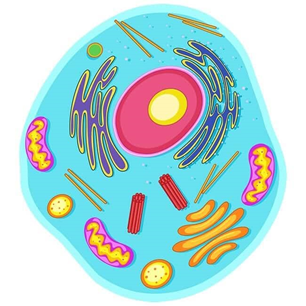
7. What is the cell membrane?
Answer: The cell is enclosed by a thin outer boundary, called the cell membrane Most cells have a distinct, centrally located spherical structure called the nucleus The nucleus is surrounded by a jelly-like substance called cytoplasm.
8. What is tissue?
Answer: A tissue is a group of cells that perform specialized function in an organism. For example, the vascular tissue for the transport of water and nutrients in the plant is called the xylem.
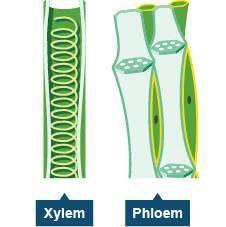
9. What are the main requirements of photo synthesis?
Answer: Chlorophyll, sunlight, carbon dioxide and water are necessary to carry out the process of Photosynthesis.
10. Explain the process of Photosynthesis?
Answer: Carbon dioxide from air is taken in through stomata. chlorophyll helps leaves to capture the energy of the sunlight. This energy is used to synthesize (prepare) food from carbon dioxide and water. Since the synthesis of food occurs in the presence of sunlight, it is called photosynthesis.
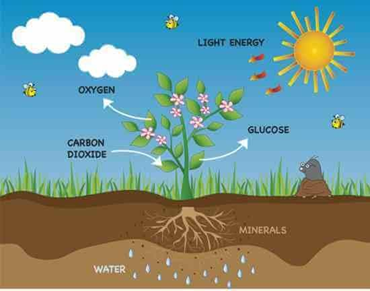
11. Why sun is called the ultimate source of energy for all living organisms?
Answer: The solar energy is captured by the leaves and stored in the plant in the form of food. and this in turn use by other organism to get food to obtain energy Thus, sun is the ultimate source of energy for all living organisms.
12. Why algae are green in colour?
Answer: Algae contain chlorophyll which gives them the green colour. It can also prepare their own food by photosynthesis.
13. What are the main components presents in carbohydrates?
Answer: The main components present in carbohydrates are carbon, hydrogen and oxygen.
14: Differentiate between nutrients and nutrition.
Answer: Carbohydrates, proteins, fats, vitamins and minerals are essential components of food, these components are called nutrients, but Nutrition is the mode of taking food by an organism and its utilisation by the body.
15: Differentiate between autotrophs and heterotrophs.
Answer: Green plants are called autotrophs as they prepare their own food from simple substances, but animals and most other organisms are called heterotrophs as they take in ready-made food prepared by the plants.
16: Explain the food factory of plants.
Answer: Leaves are called food factory of plants, as the synthesis of food takes place in leaves of plants. Water and minerals present in soil are absorbed by roots and transported to leaves via stem. Carbon dioxide from air is taken in through tiny pores on surface of leaves called stomata.
17: How water and minerals are transported to leaves from roots?
Answer: There are vessels inside a plant which run like pipes throughout the root, stem branches and leaves, by going through these vessels water and minerals are transported to leaves from roots.
18: Draw a labelled diagram of cell showing nucleus and cytoplasm.
Answer:
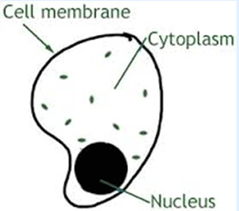
19: Define chlorophyll.
Answer: Chlorophyll is the green colour pigment which helps leaves to capture energy from sunlight to carry out the food making process of plants by the leaves.
20: Explain the role of chlorophyll in the process of photosynthesis.
Answer: Chlorophyll is the green colour pigment which helps leaves to capture energy from sunlight to carry out the food making process of plants by the leaves. It is the green photosynthesis pigment which provides energy necessary for photosynthesis.
21: Define photosynthesis along with the equation for the same.
Answer: Photosynthesis is the food manufacturing process of green plants containing chlorophyll, in presence of sunlight, with the help of carbon dioxide and water to synthesise carbohydrates. The equation for the process is as follow:
Carbon dioxide + water —> carbohydrate + Oxygen
22: What is the function of stomata in leaf of a plant?
Answer: Stomata are the tiny pores present on the surface of leaves which helps in exchange of gases, the pores in stomata are surrounded by guard cells.
23: Why do we need food?
Answer: Living organisms need food to build their bodies, to grow, to repair damaged parts of their bodies and provide with energy to carry out life processes.
24: Draw a labelled diagram showing the process of photosynthesis.
Answer:
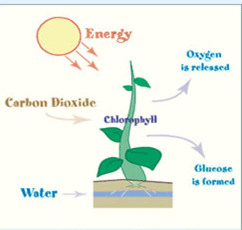
25: Draw diagram of a leaf showing chlorophyll, and stomata in it.
Answer:
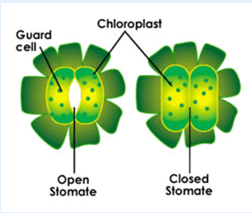
26: What is the cell membrane?
Answer: The cell is enclosed by a thin outer boundary, called the cell membrane Many cells have a distinct, centrally located spherical structure called the nucleus. The nucleus is surrounded by a jelly-like substance called cytoplasm.
27: What are the main requirements of photosynthesis?
Answer: Chlorophyll, sunlight, carbon dioxide and water are necessary to carry out the process of Photosynthesis.
28: Why colours of algae are green?
Answer: Algae contain chlorophyll which gives them green colour and because of chlorophyll it can also prepare their own food by photosynthesis.
29: What are the main components presents in carbohydrates?
Answer: The main components presents in carbohydrates are carbon, hydrogen and oxygen.
30: From where do the plants obtain nitrogen?
Answer: Soil has certain bacteria that convert gaseous nitrogen into a usable form and release it into the soil. These soluble forms are absorbed by the plants along with water. By adding fertilizers rich in nitrogen to the soil farmers also made nitrogen available for plants.
31: Define insectivorous plants along with examples.
Answer: There are few plants which can trap insects and digest them. Such plants may be green or of some other colour. Such insect-eating plants are called insectivorous plants. Example: Venus Flytrap and Pitcher plant.
32: Explain how Pitcher plants get their nutrition?
Answer: When an insect lands in the pitcher, the lid closes and the trapped insect gets entangled into the hair. The insect is digested by the digestive juices secreted in the pitcher.
Long Answer Type Questions
1: Sun is called the ultimate source of energy for all living organisms. Comments.
Answer: The solar energy is very important to carry out the process of photosynthesis, it is captured by the leaves and stored in the plant in the form of food. And this in turn use by other organism to get food to obtain energy Thus, we say that sun is the ultimate source of energy for all living organisms.
2. What is Symbiosis? What is Symbiotic relationship?
Answer: Symbiosis: It is the type of nutrition in which two different kinds of depend on each other for their nutrition. In this both the organisms are benefited by each other Example: Lichen. In this one alga and one fungus live together and remain in symbiotic relationship.
Symbiotic Relationship: Some organisms live together and share shelter and nutrients. This type of relationship is called symbiotic relationship.
3: Explain the two mode of nutrition in plants.
Answer:
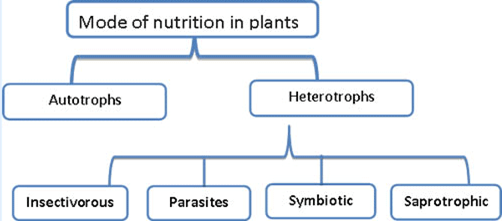
Autotrophs or Autotrophic: – In this mode of nutrition organisms make their food themselves from simple substances. All green plants are Autotrophs (Auto means self and trophs means nourishment)
Heterotrophs or heterotrophic: – Heterotrophic organisms are those who obtain food from other organisms. Since these organisms depend on other organisms for their food, they are called consumers. All animals and non-green plants like fungi come under this category.
4. What are stomata? Explain their function.
Answer: Stomata are tiny pores on the underside of the leaf surface that are surrounded by guard cells. Their functions are to exchange gases by diffusion for photosynthesis and respiration and to cause transpiration by evaporation of water from the leaf surface.
5. How is sunlight used by the plant for photosynthesis?
Answer: Sunlight is the energy source for photosynthesis. It is trapped by the green pigment chlorophyll that is present in the leaves and all green parts pf the plants. The chlorophyll is present in organelles called chloroplasts. Most of the chlorophyll is present in the leaves and therefore leaves are the major site for trapping sunlight to convert it to chemical energy.
6. Explain how photosynthesis occurs in plants.
Answer: Photosynthesis is the process by which solar energy is converted to chemical energy by the green plants. In this process simple inorganic molecules like carbon dioxide and water are used to synthesise organic food like starch. The reaction requires energy from sunlight. Sunlight is trapped by the pigment chlorophyll present in the leaves. The raw materials for photosynthesis are carbon dioxide and water. Carbon dioxide is absorbed from the atmosphere whereas water is absorbed from the soil. The energy from sunlight converts carbon dioxide and water to starch and oxygen. Starch is used as food by plants and other animals whereas the oxygen is released into the atmosphere. The overall reaction of photosynthesis can be represented as follows:

7. How do plants obtain nutrients other than carbohydrates?
Answer: Plants synthesise carbohydrates using energy from sunlight to convert carbon dioxide and water to starch. The other nutrients are however obtained directly from soil. Nitrogen is absorbed as soluble nitrogen compounds from the soil. The nitrogen compounds are present in the soil due to the action of nitrogen fixing bacteria like Rhizobium that live in symbiotic association with roots of leguminous plants. Nitrogen compounds can be replenished by the addition of fertilizers and manure to the soil. Some plants like the pitcher plant and Venus flytrap fulfill their nitrogen requirements by insectivory. In this case the insects are trapped and digested by plant parts and the nutrients are released into the plant body.
8. What is the mode of nutrition in fungi?
Answer: The mode of nutrition in fungi is heterotrophic. They cannot synthesize their own food and are dependent on other ‘organisms’ for their carbon source. They perform extracellular digestion by releasing enzymes into their environment and obtain organic and inorganic nutrients through absorption.
There are three main ways of obtaining nutrition:
(i) Saprotrophic: Decomposition of ‘dead organic matter’.
(ii) Parasitic: Feeding from a living host.
(iii) Mutualism: Living in a mutually beneficial interaction with another organism.
Example: lichen is a mutualism between fungi and algae).
9. How can we demonstrate that chlorophyll is necessary for photosynthesis?
Answer: Importance of chlorophyll can be demonstrated by using a variegated leaf. The outline of the leaf is traced on a paper and the green areas are marked before the start of the experiment. The leaf is placed in sunlight for few hours to allow photosynthesis. The leaf is then decolourized by boiling in alcohol. To this iodine solution is added. It can be observed that the green areas of the leaf turn blue-black in response to iodine solution indicating the presence of starch. Thus it can be seen that photosynthesis occurs in the green areas of the variegated leaf showing that chlorophyll is important for photosynthesis.
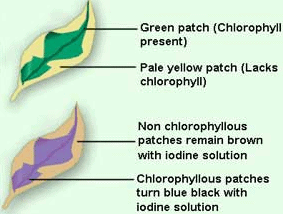
10: Why do organisms need to take food?
Answer: Food is required by all living organisms mainly for four reasons or purposes:
- Food helps a living organism to grow. If enough food is not given or if, the food given is not of right kind, the organism will not have proper growth.
- Another important function of food is to provide energy which is required for any living organism for movements and other activities.
- Food is also needed by living organisms for replacement and repairing of their damaged parts.
- Food provide us the power to fight against infections and diseases.
11: Distinguish between a parasite and a saprotroph.
Answer:
| Parasite | Saprotroph |
| A parasite takes ready made food from the organism on which it feeds. | They secrete the digestive juices on the matter they live and convert it into a solution and then absorb it. |
| They feed on a living organism. | They feed on dead and decaying organism. |
| The organism on which it feeds is called host | They do not feed on a living organism. |
| It deprives the host of valuable nutrients. | There is no host at all. |
12: Give a brief description of the process of synthesis of food in green plants.
Answer: Leaves have a green pigment called chlorophyll. In presence of sunlight, they use carbon dioxide and water to synthesize carbohydrate. During this process oxygen is released. The carbohydrates ultimately get converted into starch. Carbon dioxide from air is taken through stomata. Water and minerals are absorbed by roots and transported to leaves.
13. Whether food is made in all parts of a plant or only in certain parts?
Answer: Only certain part plant like leaves having green pigment chlorophyll. So Leaves are called the food factories of plants.
Besides leaves, photosynthesis also takes place in other green parts of the plant — in green stems and green branches. The desert plants have scale- or spine-like leaves to reduce loss of water by transpiration. These plants have green stems which carry out photosynthesis.
14. How do the raw materials transport them to the food factories of the plants?
Answer: Plants have pipe-like vessels to transport water and nutrients from the soil. The vessels are made of special cells, forming the vascular tissue. The vascular tissue for the transport of water and nutrients in the plant is called the xylem. The vascular tissue for the transport of water and nutrients in the plant is called the xylem. Thus, xylem and phloem transport substances in plants.
15. Why are leaves called the food factories of plants? Explain.
Answer: Leaves are called the food factories of plants due to following functions:
1. Green leaves have all the raw materials necessary to carry the process of photosynthesis.
2. They have chlorophyll (green pigment) which captures the energy of sunlight.
3. Leaves consist of tiny pores called stomata on their surface.
4. Carbon dioxide from air is taken in through stomata.
5. Water and minerals are absorbed by the roots from the soil and transported to the leaves by vessels.
16: How would you test the presence of starch in leaves?
Answer: Take a potted plant which has been exposed to sunlight and pluck a leave from the plant. Then boil it in water for 5 min to soften it and then place the leave in a test tube containing alcohol ,place the test tube in a beaker containing water gently heat the beaker till the alcohol dissolves in the chlorophyll and the leaves loses its green colour. Now wash the leaf with water and then place it on a plate and add a few drops of iodine solution the parts that turn blue black show the
17: How humans and animals are directly or indirectly dependent on plants?
Answer: All living organisms require food. Plants can make their food themselves by organic substances but animals including humans cannot make their food themselves. They get it from plants or animals that eat plants. Thus, humans and animals are directly or indirectly dependent on plants.
18: Whether food is made in all parts of a plant or only in certain parts? Explain.
Answer: Only certain parts of plant like leaves have green pigment called chlorophyll. So Leaves are called the food factories of plants. Besides leaves, photosynthesis also takes place in other green parts of the plant like in green stems and green branches. The desert plants have scale or spine like leaves to reduce loss of water by transpiration. These plants have green stems which carry out the process of photosynthesis.
19: What is cell?
Answer: The body of living organisms are made of tiny units called cells, therefore Cell are called the building blocks of living organism. Cells can be seen only under the microscope. Some organisms are made of single cell they are called Unicellular. Ex. Amoeba, Paramecium etc. While others are made of multicells and are called multicellular. Ex. man, tree etc.
20: What is saprotrophic mode of nutrition?
Answer: This mode of nutrition in which organisms take in nutrients in solution form from dead and decaying matter is called saprotrophic nutrition. Plants which use saprotrophic mode of nutrition are called saprotrophs. Example Fungi that secrete digestive juices on the dead and decaying matter and convert it into a solution. Then they absorb the nutrients from it.
21: What do you understand by symbiotic relationship present in some organism?
Answer: Some organisms live together and share shelter and nutrients. This is called symbiotic relationship. E.g. an alga, and a fungus live together fungus provides shelter, water and minerals to the alga and, in return, the alga provides food which it prepares by photosynthesis. In this kind of association both partners are benefited.
22: How nutrients are replenished in soil?
Answer: Nutrients are replenished in soil by following ways:
- By spreading manure or fertilizers that contain nutrients such as nitrogen in the fields
- By the bacterium Rhizobium that is commonly present in rot nodules of leguminous plant that can take atmospheric nitrogen and convert it into a soluble form like nitrates.
23: What do you mean by Symbiosis?
Answer: Symbiosis is the type of nutrition in which two different kinds of organisms depend on each other for their nutrition. In this both the organisms are benefited by each other e.g., lichen is a symbiotic association between algae and fungi. In this one alga and one fungus live together and remain in symbiotic relationship.
24: What is the role of leguminous plants in replenishing soil fertility?
Answer: Rhizobium is a type of bacteria that cannot make its own food and lives in the roots of gram, peas, moong beans and other legumes, it converts atmospheric nitrogen into usable form which increases the fertility of soil, and legumes provide food and shelter to the bacteria.
25: What do you mean by parasitic nutrition?
Answer: The mode of by which parasitic organism get and synthesize their food is called parasitic nutrition. Example Cuscuta. It does not have chlorophyll; it takes readymade food from the plant on which it is climbing. The plant on which it climbs is called a host. In a parasitic nutrition only one of the partners is benefited and other is not.